Japan's Supercar Killer Comes Back Even Stronger
Invincible. According to Webster's, the word means "incapable of being conquered, overcome or subdued." The adjective is often used to describe something so superior that it's nearly impossible to overthrow. Want to know what invincibility feels like? Strap yourself into the driver's seat of the 2012 Nissan GT-R, and then press the start button.
Just three years after successfully launching its flagship performance vehicle on our shores, the engineers at Nissan have introduced a subtly but completely reworked supercar. The engine has more power, the suspension has been revised, the wheels are lighter, the seats have been redesigned, the brakes are bigger, the chassis is stiffer and the aerodynamics have been reconfigured to improve cooling and provide more downforce. This isn't a manufacturer's token "mid-cycle refresh" to boost sales; these are changes that improve the overall drivability and performance of the GT-R so significantly that most will be inclined to consider it nothing short of a second-generation rebirth.
For starters, how does 0-60 in 2.88 seconds sound?
Continue reading...
2012 Nissan GT-R - Click above for high-res image gallery
Invincible. According to Webster's, the word means "incapable of being conquered, overcome or subdued." The adjective is often used to describe something so superior that it's nearly impossible to overthrow. Want to know what invincibility feels like? Strap yourself into the driver's seat of the 2012 Nissan GT-R, and then press the start button.
Just three years after successfully launching its flagship performance vehicle on our shores, the engineers at Nissan have introduced a subtly but completely reworked supercar. The engine has more power, the suspension has been revised, the wheels are lighter, the seats have been redesigned, the brakes are bigger, the chassis is stiffer and the aerodynamics have been reconfigured to improve cooling and provide more downforce. This isn't a manufacturer's token "mid-cycle refresh" to boost sales; these are changes that improve the overall drivability and performance of the GT-R so significantly that most will be inclined to consider it nothing short of a second-generation rebirth.
For starters, how does 0-60 in 2.88 seconds sound?
Continue reading...
Photos copyright ©2011 Drew Phillips / AOL
This story really started three years ago this April. That was when we first drove the then-all-new 2009 Nissan GT-R, the spiritual descendant of a long lineage of epic Nissan Skyline sports cars.
Its performance was mind-boggling at the time. Under the hood was a twin-turbocharged 3.8-liter V6 developing 480 horsepower and 430 pound-feet of torque. Mated to a standard six-speed sequential dual-clutch rear transaxle, power was sent to the ground through the automaker's ATTESSA E-TS all-wheel-drive system. Nissan didn't officially quote performance figures at the time, but most publications clocked the GT-R's sprint to 60 mph in a scant 3.5 seconds. Quick on the street, it was even more capable on the track. Succinctly delivering this point, its Nürburgring time of just 7:38 put it ahead of the famed Porsche 911 Turbo and Mercedes-Benz SLR McLaren.
As good as the sports car was, the GT-R's chief vehicle engineer, Kazutoshi Mizuno, never considered the car "done." In fact, Mizuno promised the "real GT-R" would arrive in a few years.
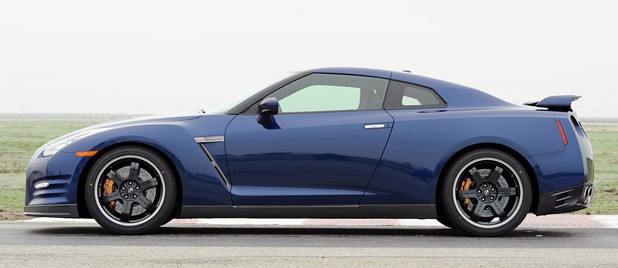
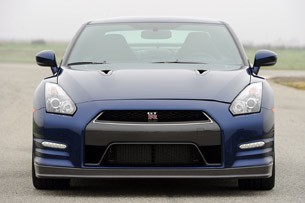
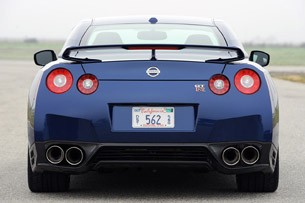
Today, I find myself sitting in a meeting room at the Carlton Hotel in Atascadero, California, smack in the middle of the state's central coast. Mizuno is explaining to a handful of journalists the changes that Nissan made to the GT-R for the 2012 model year. Like a proud father (and with every bit as much boast), he goes over each of the vehicle's upgraded subsystems methodically. The details are impressive.
While the GT-R has aged very well, Nissan refuses to let its flagship supercar fall from the front of the pack. Pursuing that sole objective, the automaker has made minor changes each year. And, with the exception of the launch control debacle and a series of not-so-insignificant price increases, enthusiasts have welcomed these tweaks that have continued to improve the coupe's performance envelope. However, none of the revisions have been as significant as the changes for 2012.
Beginning with the exterior, Nissan has improved the GT-R's aerodynamics by reducing overall drag and increasing downforce. The front fascia has been enlarged and the grille openings altered slightly to reroute air precisely around the vehicle. As Mizuno explains, air forced through the front intake is channeled through the radiators and intercooler before being released into the back of the brakes for cooling. Airflow that normally would have spilled over the hood has been redirected to the sides. Not only does this improve air volume through the radiator and front brakes, but the overall coefficient of drag is down to .268 (last year, it was .272) and downforce on both axles has been increased by 10 percent. From the outside, the new front fascia is visually distinguished by its double rectifier fins and integrated white LED running lights.
In the back, the diffuser has been extended and resculpted to improve airflow over the exhaust components (plus, it also serves to lower air resistance). The new rear fascia outlet and slots on the lower rear fenders are both engineered to help pull air from the rear wheel wells to improve brake cooling. More visible to the naked eye are the new vents behind the rear wheels and the larger diameter exhaust tips, which are purely cosmetic.
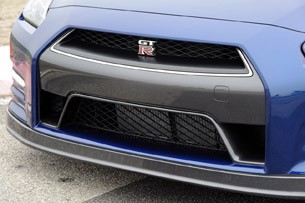
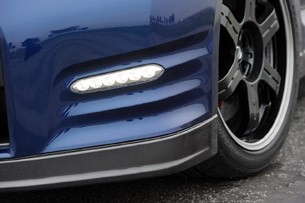
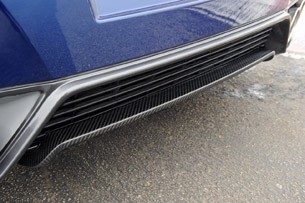
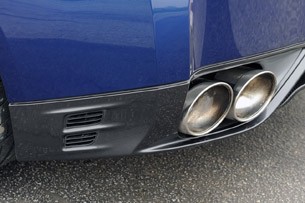
The seven-spoke forged alloy wheels found on 2009-2011 Nissan GT-R models have been replaced in 2012 with new ten-spoke forged alloys that are reportedly more rigid and slightly lighter than their predecessors, coming in at 26.4 pounds each. Knurling inside the 20-inch wheels has been modified to help keep the tires from slipping during extreme acceleration or braking, and the finish on the wheels has also been slightly darkened. While predecessors were fitted with rubber from different manufacturers, tires for all 2012 models are specially constructed Dunlop SP Sport Maxx GT 600 DSST CTT ultra high-performance run-flats (filled with nitrogen). The fronts are size 255/40ZRF20 while the rear tires are 285/35ZRF20. If Godzilla is forced to endure colder climes, customers may also order all-season run-flat tires as part of the Cold Weather Package.
Stiffening of the chassis has been accomplished by adopting a carbon composite strut support bar in the engine bay (connected just behind the front strut towers). The dampers are now fitted with aluminum free pistons, and the front caster and rear geometry have been altered to slightly lower the roll center height.
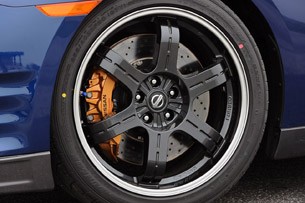
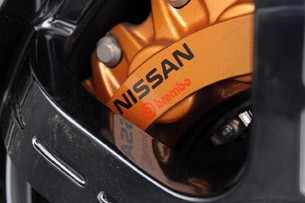
In addition to the aforementioned increased airflow to the brakes, the coupe's standard Brembo monobloc six-piston front calipers clamp down on slightly larger 15.4-inch rotors (up from 15-inches), while the rear four-piston calipers and rotors are carried over from last year. The system utilizes a full-floating cross-drilled two-piece rotor with special low-steel high-stiffness brake pads.
Saving the go-fast news for last, Mizuno explains how his team of engineers made several significant changes to the VR38DETT twin-turbocharged 3.8-liter six-cylinder engine. To increase power, boost pressure was increased and modifications were made to both the valve timing and mixture. The intake and exhaust system was also opened up to improve breathing. The result is a big jump in output, now 530 horsepower and 448 pound-feet of torque. The torque curve has also been widened, with peak twist now available from 3,200 rpm all the way up to 6,000 rpm. And it's not a coincidence that the horsepower rating is identical to the Porsche 911 Turbo S. And, if you are one of those debating between a Nissan Leaf and a Nissan GT-R, fuel economy for the 2012 model is up to 16 mpg city / 23 mpg highway (the 2011 was rated 15 mpg city / 21 mpg highway).
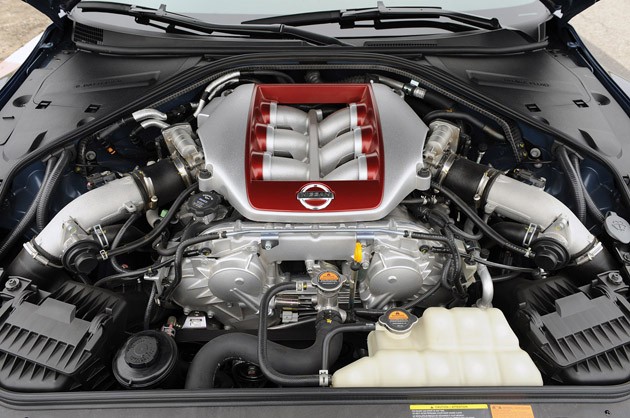
The engineering team also tweaked and massaged the GT-R's dual-clutch six-speed transmission. Most of the work focused on eliminating the brutal shock of engagement during periods of maximum stress (leaving more than a few early owners with shattered gearboxes). According to Mizuno, software remapping upgraded the vehicle's so-called "clutch control" to deliver launches that were quicker, yet less traumatic to the mechanicals. That said, owners of the 2012 model are offered "launch control" with a 4,000-rpm launch, with one caveat: The software will allow only four sequential runs back-to-back. After that, the car must be driven one-and-a-half miles to reset the system (the pause is said to allow the system time to cool down). The last minor change: The transmission's lethargic "snow mode" has been replaced with a "fuel economy mode" for wishful eco-boosting hypermilers. Suuuuurrrre.
In a rare move for Nissan, the automaker has released performance figures (well, at least Muzuno has). Thanks to the increased power and torque, and the subtle mapping tweaks to the dual-clutch transmission's software, the 2012 GT-R will crack 60 mph in 3.0 seconds. Its top speed is now 197 miles per hour (up from its predecessor's 193 mph). The evening before we arrived, Nissan engineers were at the track trying to improve the already impressive acceleration number. Their best was a reported 0-60 sprint in just 2.88 seconds. It may be difficult to repeat, but the lesson learned is don't mess with the GT-R.
Nissan dropped trim levels last year, but two will be offered in 2012. All models receive new carbon fiber accents on the center console and re-sculpted sport bucket seats. Standard models are labeled GT-R "Premium" – they come loaded with everything including navigation, heated seats and the Bose audio package. A new-for-this-market GT-R "Black Edition" (the dark blue vehicle in our gallery) features red-trimmed Recaro seats with accenting red and black interior trim and a dark headliner. To further differentiate it from its Premium sibling, the wheels on the Black Edition coupes are unique six-spoke forged-aluminum Rays (wrapped in the same tires as found on the Premium models). In addition to the standard exterior colors (Solid Red, Gun Metallic and Pearl White), Nissan has added Deep Blue Pearl and Jet Black to the color palette for 2012. A sixth color, the four-stage metallic Super Silver, is still offered in limited volumes.
While the 2009 Nissan GT-R arrived with an aggressive base price of just $69,850 three years ago, the 2012 Nissan GT-R commands a significantly thicker wallet. The Premium model is priced at $90,950. The sole option is the Cold Weather Package (with Dunlop SP Sport 7010 all-season run-flat tires and a 30/70 coolant/water mix). The Black Edition models have a base price of $96,100.
After an early breakfast with Mizuno, a convoy of GT-Rs left Atascadero for the three-hour back road drive to Buttonwillow Raceway, just west of Bakersfield. Our scenic route took us to the Pacific coast at Morro Bay, then back over the hills to Buttonwillow via California Highway 58. Settled into the new front seats (noted for their additional bolstering and firmer cushions), the ride was comfortable without being awkwardly harsh. The brakes are strong and squeak-free, and the steering is nicely weighed. The sound level within the cabin is loud, attributed to the noise from the performance tires. Visibility to the rear quarters is challenging and the transmission still makes an unpolished rattling noise at crawling speeds (somehow, it doesn't seem to affect gearbox operation). The reality is that none of those irritants would have deterred us from driving all the way to the Atlantic coast, had that been the assignment.
When driven with temper and patience, the powertrain quickly shifts through its gears to maximize fuel economy. Again, no worries from the driver's seat as instant acceleration is but a quarter-throw of the accelerator pedal away. The GT-R is much, much more enjoyable when driven hard.
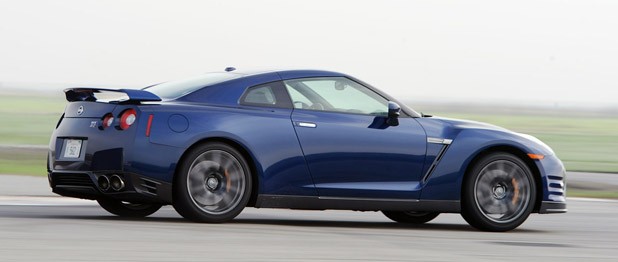

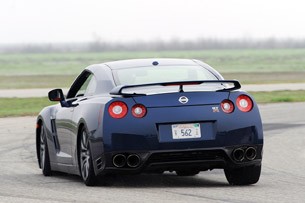
A simple three-finger salute is required to activate "Launch Control" mode. The easy one-handed operation refers to the process of lifting the trio of console-mounted switches from their standard neutral resting position into "R-Mode" (simply hold them for two seconds). Press the brake firmly with one foot and floor the accelerator with the other. Once the engine speed levels off at 4,000 rpm, situate your skull against the head restraint and side-step the brake pedal. The tire-shredding act feels a bit childish after a dozen or so times, but it never gets old. Watch a demonstration of it in action in our Short Cut video above.
Spending the afternoon on Buttonwillow's West Loop reinforced favorable memories of the GT-R's competency, and its voracious appetite for devouring a road circuit. It's not easy to hide a curb weight of 3,829 pounds (identical to last year), but Nissan's flagship overcomes the handicap with savage power and all-wheel-drive grip. Speeds are fast, easily passing triple digits on each of the short straights. I personally have been fortunate to run dozens of cars on this exact track over the past decade, but none have propelled me with such velocity.
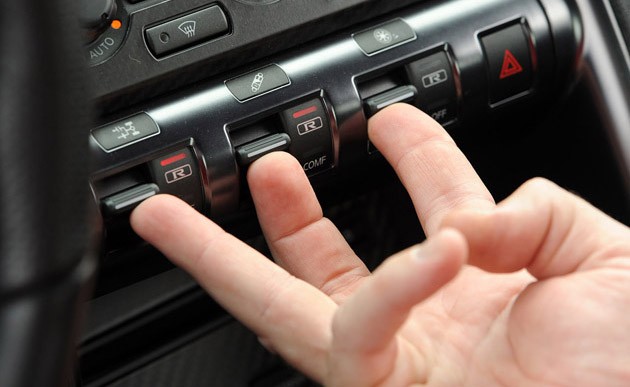
Nissan thoughtfully provided us with some 2011 models to compare against the 2012 GT-R. It offered excellent back-to-back driving impressions, but it also almost cost me some pride. After grabbing a random key at the start of the session, I drove the new model first. It seemed nearly unflappable at speed on the circuit. Any slight error in trajectory was easily corrected with the steering wheel or accelerator pedal. Lifting mid-corner would bring the tail around, and Nissan's ATTESA E-TS all-wheel drive worked full-throttle miracles on the exits. I tried the identical moves in the 2011 model and ran out of track (dropping the two outside wheels in the mud) with frustrating understeer exiting the Sweeper. It doesn't take an expert to notice the 2012 upgrades to both power and handling.
As it was before, the 2012 GT-R is still faster around the track when driven in manual mode (with the column-mounted paddle shifters). With all settings in "R" mode, the dual-clutch gearbox does a decent job grabbing the next higher gear when coming out of a corner, but it still lacks the anticipation needed to be in the thick of the torque band and get a jump on the exit. Subjectively speaking, Porsche's PDK (a seven-speed dual-clutch gearbox) still feels faster and seems to deliver more effective neck-snapping shifts in performance mode.
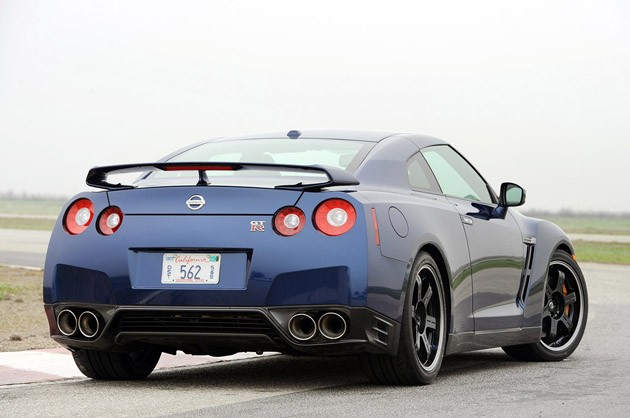
The brutality of this particular road circuit took its toll. The GT-R's upgraded brakes were overly taxed at the limit. More than once I found myself at the end of a straight coming up on 120 mph, pressing the brakes as hard as I could (according to the multi-function digital display, they were maxed at 100 percent), yet I couldn't activate the ABS. The tire's rubber compound afforded plenty of stick but the street-compound brake pad material just couldn't deliver the friction against the expansive rotor surface at the limit. Pro Tip: Those who track the GT-R will need to invest in some race-compound brake pads.
Nearly three years ago, we reviewed Godzilla and concluded that the fresh young two-door coupe delivered "robot-like mechanized perfection," yet it lacked the subtle qualities that help to create a bond between man and machine. Its individuality has improved with the arrival of the 2012 model. Now in its fourth year, the GT-R has matured and aged well. Emerging after an extensive list of focused upgrades and refinements, the sports car demonstrates poise, confidence, authority and continues to show no signs of fear. We'd go so far as to argue the GT-R finally possesses something that it lacked in the past: character.
Photos copyright ©2011 Drew Phillips / AOL


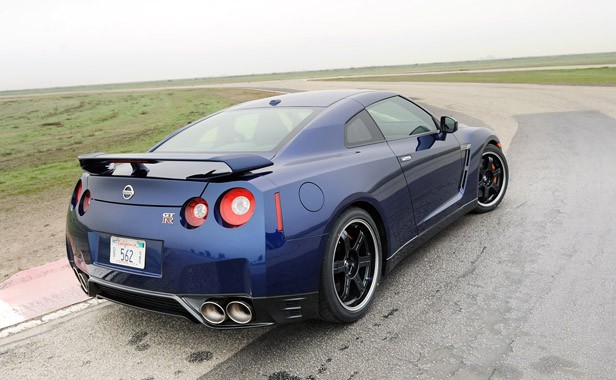
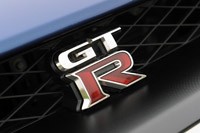
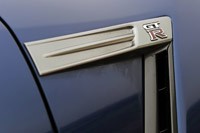
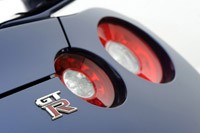
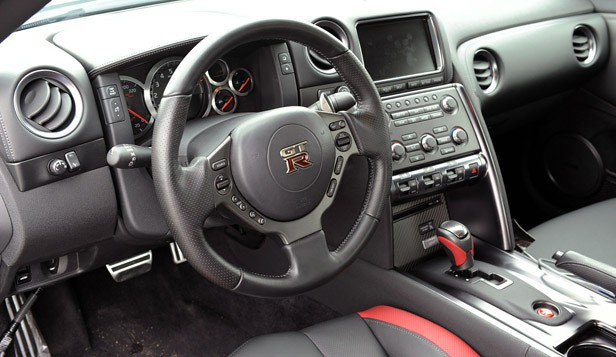
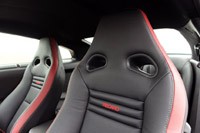
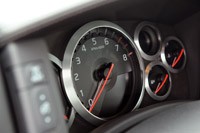
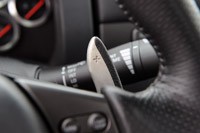

Sign in to post
Please sign in to leave a comment.
Continue